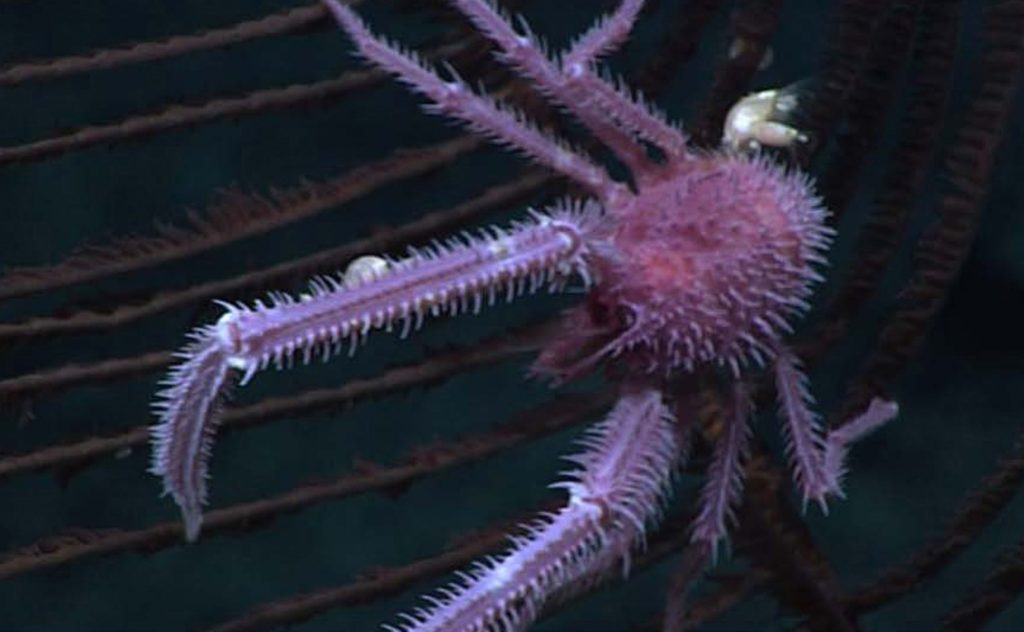Take the dive and get connected to the deep ocean during ‘Pilina Kai Lipo’ in Hilo
Kayla Harpe was a proud mama Tuesday evening, posting a photo of the painting her son created Tuesday afternoon, commenting on Jennifer Andrea’s post in the in the East Hawai‘i Events & Activities group on Facebook sharing NOAA Ocean Exploration’s reminder about “Pilina Kai Lipo: Connecting to the Deep Ocean.”
“It was a nice afternoon,” wrote Harpe. “My son painted a Casper octopus and made a ‘ghost shark’ key chain. We’re glad we went.”

The National Oceanic and Atmospheric Administration office and Mokupāpapa Discovery Center invite everyone to the center in downtown Hilo for a second day of deep sea exploration and education of their own from 10 a.m. to 3 p.m. today.
They’re sure you will be glad you took the dive, too.
The free event engages the community with the deep ocean by highligthing efforts to further understand what lies beneath the surface waters of Papahānaumokuākea Marine National Monument.
Activities include:
- Learn to draw a deep-sea creature: 10 am. to noon. Series of short sessions taught by local artist Patrick Ching. Free and open to all. No pre-registration required.
- Learn to paint a deep-sea creature: 1, 2 and 3 p.m. Classes are about 45 minutes and taught by Ching. Free, but with limited attendance; pre-registration required. Reserve a session here.
- Educational activities and products: These include deep-ocean animal coloring sheets designed by Ching, postcards, stickers, interactive poster displays and more. Available all day.
- Meet ocean explorers: Learn about their jobs, hear about what they’ve seen and done and ask questions. Available all day.
- Videos and highlights from deep-ocean exploration: See what the explorers have found in Papahānaumokuākea Marine National Monument. Available all day.
Today is the second and final day.

The event’s name celebrates the importance of indigenous traditional knowledge by informing and enriching what is learned and experienced through science operations aboard NOAA ship Okeanos Explorer, which just completed a 20-day expedition to map deep waters near Johnston Atoll within the Pacific Remote Islands Marine National Monument, and sharing this with the Hilo community.
“By weaving Western approaches to science with indigenous knowledge systems in a two-way exchange, we can build a more holistic understanding of the areas being explored,” says NOAA Ocean Exploration.
The waters in the Pacific Islands region include a range of diverse ecosystems and dynamic geological environments, some of which are the last relatively pristine marine ecosystems on the planet with numerous protected species.
The islands themselves are home to cultures with long histories of ocean voyaging and exploration, and the waters around them contain undiscovered shipwrecks and cultural landscapes sacred to the indigenous peoples of the Pacific.
That biological, ecological, cultural and geological significance led to the designation of several marine protected areas, including Papahānaumokuākea Marine National Monument and the Pacific Remote Islands Marine National Monument.
But despite their importance, these waters remain largely unexplored, particularly deep waters.
“We can’t effectively manage or protect what we don’t understand,” the NOAA Ocean Exploration said. “As we increasingly look to the deep ocean for the resources it holds and the services it can provide, more and better data are needed to help us make the right decisions to ensure the vitality of these ocean places.
The value, importance and connections to the deep ocean are spotlighted during “Pilina Kai Lipo: Connecting to the Deep Ocean” in conjunction with the Sept. 7 arrival of the Okeanos Explorer at the Port of Hilo.
The most recent expedition is one of six for the research vessel to map deep waters of Hawaiʻi and Johnston Atoll that are being led by NOAA Ocean Exploration.
In June, July and early August, the office conducted two mapping expeditions within Papahānaumokuākea and will conduct an additional expedition in the monument in October and November.
Don’t miss your chance to take a deep dive into what NOAA Ocean Exploration does and connect with the ocean in ways you might not have considered before.
Mokupāpapa Discovery Center is located at 76 Kamehameha Ave.
For more information, click here or call the center at 808-498-4709.
Sponsored Content
Comments
















